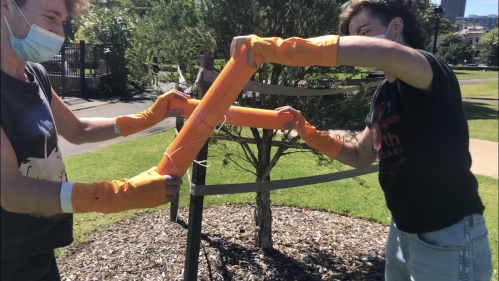APD WEEK 8
Theme: Play and Body
Response: https://youtu.be/PndrqqonP44
Context
This week’s response began with inspiration from Exertion Lab’s research into the body as play. In their research, they discuss Merleau-Ponty’s phenomenological view of the body: first as an object with structural aspects (körper), and second as the living body of feelings and sensations (leib). Often gameplay like motion sensing involves using the body to play with digital content (körper). However, Exertion proposes gameplay experiences which incorporate the leib of the body with the use of the body. They call this combination ‘the body as play’.
Kaho Abe’s Hit Me! (2011) encapsulated this idea, as users use their bodies to hit each other’s button which light up and take pictures of their faces. I loved the energy of this game, its incorporation of the body with its game props and the overall energy of between the audience and the game, similar to that of a wrestling match.
Hence, my original idea was to create a sort of oversized finger trap which incorporates the players bodies. I wanted to make it a wrestling game, with a ring and rules like sumo wrestling. The idea was the players would use their body (körper) to enact forces on each other without touching, kind of involving the ‘leib’ perspective of the body in the way Exertion Labs discuss. However, as I began making my “finger trap” I found it difficult to create something which encased the body comfortably and still had a push and pull effect even if the players weren’t touching each other. Thus, I scaled my apparatus down, and found that it was more interesting as an obstacle for the players, refocusing on the körper perspective of the body.
Method
The twenty finger trap is made by sewing a pool noodle section in the middle of a stretchy fabric tube, with finger holes cut into it. Reaching this model took some prototyping, as it needed to comfortably fit the players hands. I also discovered making something which could move the whole player's body around wasn’t as feasible.
Thus, finding the right challenges for the players was a process of exploration. I shifted towards a puzzle which could be recreated in any environment, and focused on the unique challenges the new apparatus imposed.
The goal of the game was just to use the key to open the lock on the box. The key was tied around their arms, trapped in the loop. I kept the task relatively simple, as I did not have any prior idea of how difficult it would be.
Reflection
The most rewarding part of this response was that the participants genuinely had fun. We tried a few other challenges, like climbing a bike rack and tying hair up, but doing this puzzle got them both genuinely very excited and involved. This kind of active, physical puzzle solving isn’t that present in our day to day lives, especially out in the sunlight. I think it’s mobility is part of the fun, since it seemed being outdoors in the sun made the experience more uninhibited. It seemed they were more dedicated and willing to give themselves over to the task, in a way which I don’t think would’ve been the same or as enjoyable if I locked them in a room to do it.
It was interesting that since the players had been given this tool, they both focused on using their arms/newfound arm extension and didn’t really try to use other parts of the body. I think this is in part because the finger trap draws attention to the ability of their hands, and they kind of inferred there was this rule you had to use the fingers trap. In doing so, the ‘obstacle’ kind of became more of a tool, and defined their play and problem solving. This felt reminiscent of the idea the game takes the player out of themselves (Sutton-Smith, 1997), as giving the players this apparatus led them to intuitively use it the entire time, without instruction to do so. One of the players said they liked having to follow rules to complete a certain task, reflecting the pleasure which comes from being bound to a game and enjoying the challenge of rules.
In terms of further development, I think that incorporating digital puzzles with sounds and installation spaces could lead further into the body as play which Exertion Labs discuss. This could also happen if the apparatus had a more direct feeling or sensation enacted on the players, but I think that would move the experience away from the pleasure the players experience from the task solving.
One of the participants requested I make more of these puzzles for them, and so I would like to explore this kind of paidia play experience more often. It also made me feel happy I changed my initial wrestling idea, although I think there is room for physical competition to combine with puzzles potentially. To an extent, ‘Money in the Bank’ ladder matches are one extra puzzle step away from being both a puzzle and physical competition, and could be the next evolution of this game.
